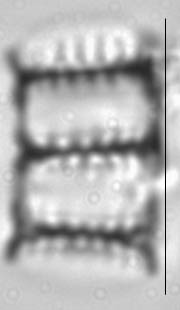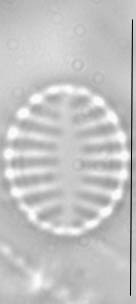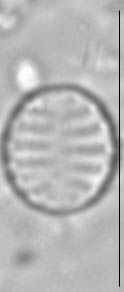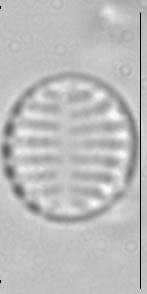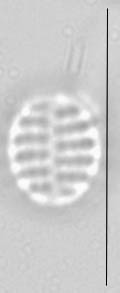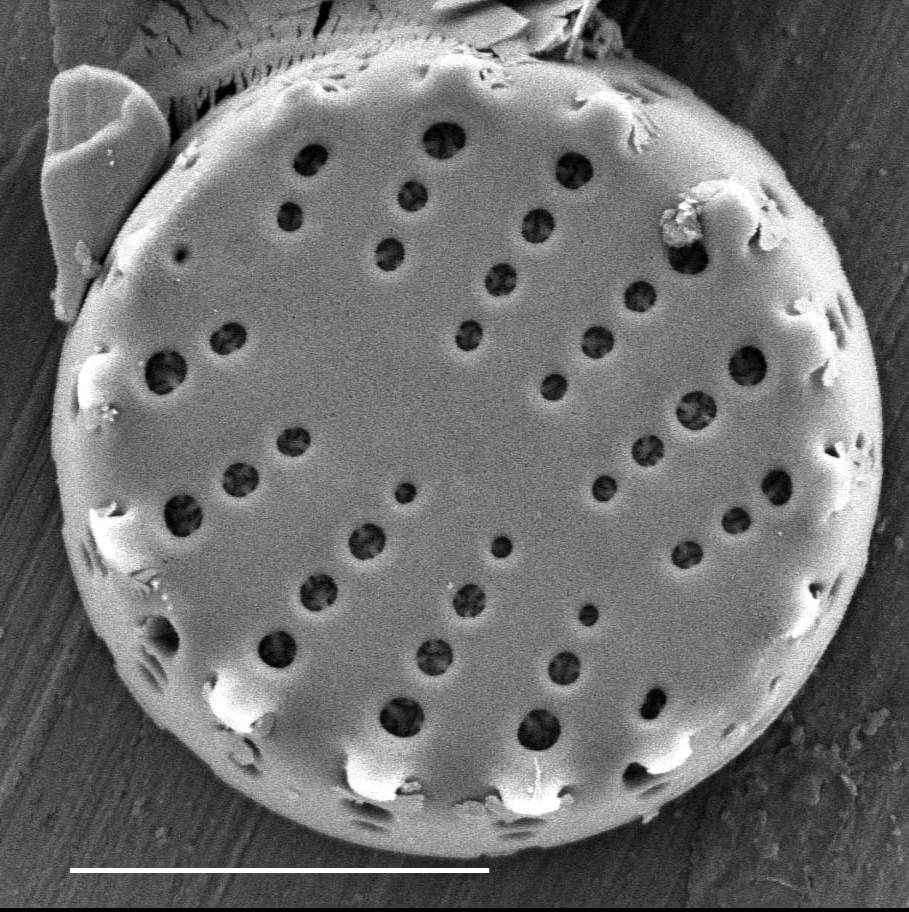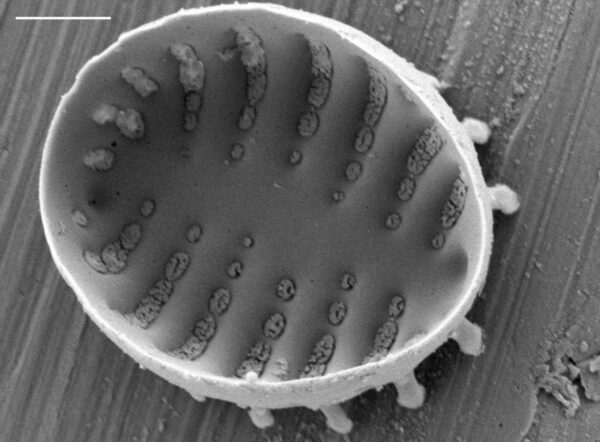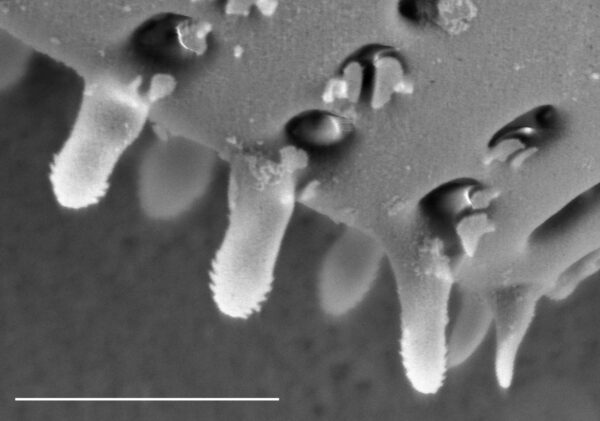Pseudostaurosira trainorii
-
Category
-
Length Range2-9 µm
-
Width Range1.5-4.5 µm
-
Striae in 10 µm18-25
-
Reported AsStaurosira elliptica ((Schumann) Williams and Round 1987)
Fragilaria elliptica (Schumann)
-
ContributorEduardo A. Morales - Apr 2013
-
ReviewerMarina Potapova - Apr 2013
Identification
Description
Cells are rectangular in girdle view and form ribbon-like colonies joined by linking spines. Valves are round to slightly elliptical. The valve face is flat, or slightly undulate due to raised costae. Valve face/mantle junction forms a sharp angle. Abvalvar edge of mantle in middle portion of valve is convex with respect to the valve face/mantle junction. The axial area is narrow to widely lanceolate, or may be linear in some specimens. Striae are distinct, alternate, and composed of round areolae decreasing in size from valve face/mantle edge to both central sternum and valve mantle. Areolae bear finely and profusely branched volae. Flaps partially cover the external opening of the areolae, especially on mantle areolae. Striae vary from parallel to radiate. Striae extend onto the valve mantle, further in smaller specimens. Costae are broad and wider than striae. Spines are spatulate, solid, possess a serrate margin and bear flaps at the base, which cover the openings of the contiguous areolae. Spines are positioned within the striae at the valve face/mantle junction. Apical pore fields absent, or reduced to two to three pores located on valve face/mantle junction. Rimoportula are absent. Scab-like structures, or blisters, are present in some specimens as depositions on the abvalvar edge of mantle. Copulae are open and lack perforations. Valvocopula are wider than other copulae. Plastids were not observed.
This taxon has been commonly reported as Staurosira elliptica (Schumann) Williams and Round. This was due to a misinterpretation of the type of Fragilaria elliptica Schumann. The type of F. elliptica has been evaluated (Edlund et al. 2006) and not only is it better placed in the genus Pseudostaurosira, Staurosira elliptica has not been confirmed in North America. Pseudostaurosira elliptica (Schumann) Edlund et al. has elliptical valves with acute ends, striae restricted to the valve margin, but lacks serrate spines - all features differ from those of P. trainori.
Autecology
Colonies are presumably attached to the substratum at one end by a frustule attached by a mucilage pad, or planktonic.
-
Size Range, µm3
-
Motility
-
BCG
-
Waterbody
-
Distribution
- Learn more about this
Citations & Links
Citations
Links
-
North American Diatom Ecological DatabaseNADED ID: 73013
Cite This Page
Morales, E. (2013). Pseudostaurosira trainorii. In Diatoms of North America. Retrieved April 27, 2024, from https://diatoms.org/species/pseudostaurosira_trainorii
Responses
The 15 response plots show an environmental variable (x axis) against the relative abundance (y axis) of Pseudostaurosira trainorii from all the stream reaches where it was present. Note that the relative abundance scale is the same on each plot. Explanation of each environmental variable and units are as follows:
ELEVATION = stream reach elevation (meters)
STRAHLER = distribution plot of the Strahler Stream Order
SLOPE = stream reach gradient (degrees)
W1_HALL = an index that is a measure of streamside (riparian) human activity that ranges from 0 - 10, with a value of 0 indicating of minimal disturbance to a value of 10 indicating severe disturbance.
PHSTVL = pH measured in a sealed syringe sample (pH units)
log_COND = log concentration of specific conductivity (µS/cm)
log_PTL = log concentration of total phosphorus (µg/L)
log_NO3 = log concentration of nitrate (µeq/L)
log_DOC = log concentration of dissolved organic carbon (mg/L)
log_SIO2 = log concentration of silicon (mg/L)
log_NA = log concentration of sodium (µeq/L)
log_HCO3 = log concentration of the bicarbonate ion (µeq/L)
EMBED = percent of the stream substrate that is embedded by sand and fine sediment
log_TURBIDITY = log of turbidity, a measure of cloudiness of water, in nephelometric turbidity units (NTU).
DISTOT = an index of total human disturbance in the watershed that ranges from 1 - 100, with a value of 0 indicating of minimal disturbance to a value of 100 indicating severe disturbance.
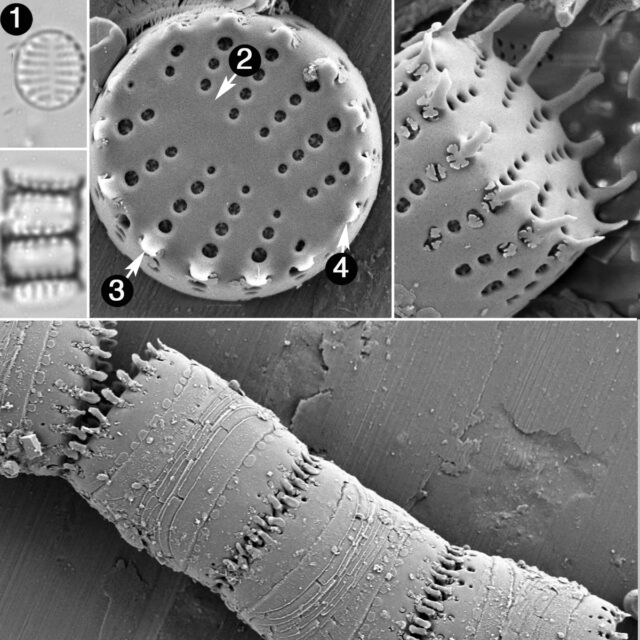
Pseudostaurosira trainorii
- Valves round to slightly elliptical
- Axial area lanceolate to linear
- Spines solid
- Spines aligned with striae
Valves are round to slightly elliptical. The axial area is typically lanceolate, but linear in some specimens. Some specimens may possess a broader axial area, but striae are never restricted to the valve margin. Spines are solid and positioned in line with striae. This taxon is difficult to recognize under the light microscope and...
 Diatoms of North America
Diatoms of North America